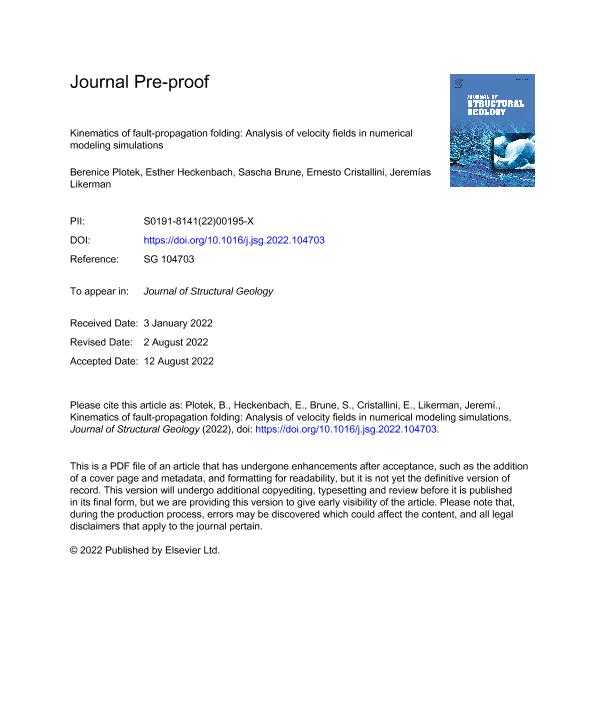Artículo
Kinematics of fault-propagation folding: Analysis of velocity fields in numerical modeling simulations
Plotek, Berenice Lia ; Heckenbach, Esther; Brune, Sascha; Cristallini, Ernesto Osvaldo
; Heckenbach, Esther; Brune, Sascha; Cristallini, Ernesto Osvaldo ; Likerman, Jeremias
; Likerman, Jeremias
 ; Heckenbach, Esther; Brune, Sascha; Cristallini, Ernesto Osvaldo
; Heckenbach, Esther; Brune, Sascha; Cristallini, Ernesto Osvaldo ; Likerman, Jeremias
; Likerman, Jeremias
Fecha de publicación:
09/2022
Editorial:
Pergamon-Elsevier Science Ltd
Revista:
Journal Of Structural Geology
ISSN:
0191-8141
Idioma:
Inglés
Tipo de recurso:
Artículo publicado
Clasificación temática:
Resumen
Fault-propagation folding occurs when a shallow fold is created by an underlying propagating thrust fault. These structures are common features of fold and thrust belts and hold key economic relevance as groundwater or hydrocarbon reservoirs. Reconstructing a fault-propagation fold is commonly done by means of the trishear model of the forelimb, a theoretical approach that assumes simplistic rheological rock properties. Here we present a series of numerical models that elucidate the kinematics of fault-propagation folding within an anisotropic sedimentary cover using complex visco-elasto-plastic rheologies. We explore the influence of different parameters like cohesion, angle of internal friction, and viscosity during folding and compare the velocity field with results from the purely kinematic trishear model. In the trishear paradigm, fault-propagation folding features a triangular shear zone ahead of the fault tip whose width is defined by the apical angle that in practice serves as a freely tunable fitting parameter. In agreement with this framework, a triangular zone of concentrated strain forms in all numerical models. We use our models to relate the apical angle to the rheological properties of the modeled sedimentary layers. In purely visco-plastic models, the geometry of the forelimb obtained can be approximated using a trishear kinematic model with high apical angles ranging between 60° and 70°. However, additionally accounting for elastic deformation produces a significant change in the geometry of the beds that require lower apical angles (25°) for trishear kinematics. We conclude that all analyzed numerical models can be represented by applying the theoretical trishear model, whereby folds involving salt layers require high apical angle values while more competent sedimentary rocks need lower values.
Archivos asociados
Licencia
Identificadores
Colecciones
Articulos(IDEAN)
Articulos de INSTITUTO DE ESTUDIOS ANDINOS "DON PABLO GROEBER"
Articulos de INSTITUTO DE ESTUDIOS ANDINOS "DON PABLO GROEBER"
Citación
Plotek, Berenice Lia; Heckenbach, Esther; Brune, Sascha; Cristallini, Ernesto Osvaldo; Likerman, Jeremias; Kinematics of fault-propagation folding: Analysis of velocity fields in numerical modeling simulations; Pergamon-Elsevier Science Ltd; Journal Of Structural Geology; 162; 9-2022; 1-14
Compartir
Altmétricas



